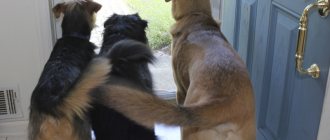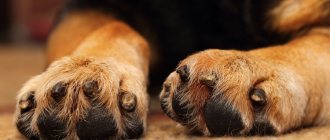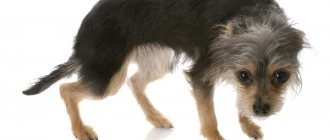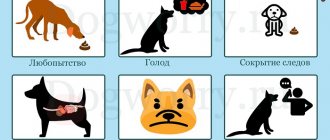Causes
If a dog chews its tail, it can be caused by three main groups of reasons:
- Itching (which, in turn, can be physiological and pathological).
- Neurosis.
- Psychological reasons.
Physiological itching
It is caused by completely ordinary reasons, and there is no illness behind it.
Most often this happens when the dog's tail is dirty with something. She feels discomfort and tries to cleanse herself. Or simply itches, slightly biting the tail.
In this case, this does not last long and the dog behaves calmly. If during the day you notice that your pet is constantly biting or even gnawing on its tail, but there are no foreign objects or dirt in the fur. This is a warning sign. We need to find out the reason.
Pathological itching
Caused by disorders in the body or invasion. Your dog may have itchy skin at the base of his tail, the tail itself, or the area around the anus.
Because of this, the dog is constantly in an excited state and feels severe discomfort and can gnaw its tail even until it bleeds. The most common pathologies that cause this symptom:
Skin parasites.
It could be fleas or ticks. Remember that fleas do not live on animals, they only feed on them. Therefore, sometimes you may not even see parasites, but they will bother your pet.
Ticks.
As a rule, when a dog is bitten by an Ixodid tick, it does not feel it, so it is unlikely that such a reaction will occur to a regular tick.
But if you remove a tick from your pet, carefully monitor its condition! There is a possibility of piroplasmosis!
But if the dog is overcome by scabies mites, then severe itching is guaranteed. And you won’t be able to see them with the naked eye either.
On the tail itself, skin parasites have nothing to do; they will rather be localized on the skin near it. And from the outside we will see that the dog is furiously gnawing the root of its tail.
Internal parasites (worms).
Those helminths that are localized in the intestines can cause itching in the rectum. This usually occurs with severe infestation. The itching spreads to the anus, the dog experiences discomfort, does not understand what is happening and may begin to chew its tail, trying to get rid of the itching sensation.
Inflamed paraanal glands.
Under normal conditions, the paraanal glands do not bother our four-legged friends. They are located on the sides of the anus, normally they are not noticeable, and they self-clean during the act of defecation.
In some cases, they can become clogged and inflamed, this is especially common among small dog breeds.
In such cases, the pet experiences severe discomfort and itching. To get rid of it, he may start biting or even gnawing at the base of the tail.
Dermatological diseases.
Skin diseases can have different origins. They can be caused by fungi, bacteria, and parasites. But regardless of origin, they are almost always accompanied by itching. To suspect a dermatological problem, it is enough to examine your pet and see obvious skin lesions. But this is not enough to help the pet.
There are many diseases, so you should always contact a veterinary dermatologist to make an accurate diagnosis.
Allergy.
Allergies can be triggered by food and flowers, as well as household chemicals. Allergies quite often manifest as excessive dry skin, redness and severe itching. Sometimes only the last one. You can often see a dog chewing its tail and paws.
Injuries.
Tail fractures are more common in practice than it seems. And this behavior of the dog only worsens the situation. The dog is experiencing pain in its tail and wants to get rid of this pain. Sometimes she gets angry at her own tail because it causes discomfort.
In this case, you may see the dog chewing its tail and whining as it does so. You can’t leave everything as it is; be sure to take your pet to the veterinarian; part of the tail may have to be amputated.
Neuroses
Neurotic disorders are a very complex topic. They are associated with inhibition or overexcitation of the nervous system, disorders of the conduction of nerve impulses.
These pathologies manifest themselves in different ways, depending on the cause, stage and nature of the disorder.
Such disturbances may be accompanied by changes in behavior. Just one example is the phenomenon when a dog angrily gnaws its tail until it bleeds.
This condition is dangerous both for the animal itself and for everyone around it.
As a rule, this condition has prerequisites:
- inhibition of normal reactions;
- on the contrary, overexcitation;
- unusual reaction to stimuli;
- the animal is in constant fear and tension.
The causes of neurosis can be:
- prolonged exposure to severe stress;
- exhaustion;
- severe overloads;
- intoxication and some infectious diseases.
Neurosis is a very serious disease. Tail biting is usually a symptom of the onset of the disease. That's why you shouldn't turn a blind eye to it. It is better to contact a veterinarian in a timely manner.
Psychological reasons
Neurosis and psychological disorders are different things. In neurosis, there is already damage to the nerves or cerebral cortex. With psychological disorders there is no direct damage.
Some dogs are prone to stress, and often it manifests itself in this very behavior - the dog begins to chew. It could be foreign objects, or maybe his own tail.
Stress in dogs can be caused by:
- moving;
- severe fear;
- long absence of the owner, boredom;
- resentment towards the owner;
- climate change.
Sometimes a psychological disorder may only manifest itself as a dog chewing its tail, without other changes in behavior.
Why do dogs chew their tail?
Sometimes some dog owners observe a picture of a dog chewing its tail. If this happens in puppies when they try to play with their tail as a game, mistaking it for a toy, then in adult dogs a similar phenomenon should alert the owner. A dog sometimes zealously bites into its tail and this may be a sign of some kind of disease.
Reasons why a dog may chew its tail.
Skin parasites. Dogs affected by skin parasites such as:
Fleas. Flea infestation in dogs is quite common. Fleas cause a dog, and its owner, a lot of pain and trouble. Not a single dog is immune from flea damage, especially in the summer, when your pet, in order to understand the world around him, and sometimes get to know his relatives, actively contacts them during his walk.
Clinical picture. The dog becomes restless, becomes irritable, suddenly jumps up sharply, itches, and bites itself. Characteristic of flea infestation in dogs is the presence during a clinical examination of the dog of severely itchy papulocrustous areas located in the root of the tail, on the caudomedial surface of the thighs, abdomen, groin area and neck. Upon visual inspection, you may notice whitish grains (flea eggs) or dark particles of flea droppings on the dog’s fur. At a later stage, when a dog is infected with fleas, flea eggs and particles of their excrement can be seen on the bedding and in places where the dog is often found (fleas in dogs).
Ringworm (ringworm in dogs) and scabies (mange in dogs).
Inflammation of the paraanal glands (inflammation of the paraanal glands in a dog).
Dermatitis including allergic dermatitis. This form of dermatitis is by far the most common in dogs and is usually seasonal during the flowering of plants and trees. There is evidence that allergic dermatitis can be inherited. This type of dermatitis is also facilitated by the fact that modern industrially produced dog food contains many different preservatives, dyes, and sometimes flavors. In addition to the symptoms of dermatitis (the dog is constantly itching, the skin becomes thick and red, the coat begins to thin, the skin becomes hyperpigmented), the dog may suddenly develop anaphylactic shock and death (dermatitis in dogs).
Staphylococcal infection in dogs. With weeping dermatitis, rapidly developing skin lesions may involve the groin, dewlap, neck and tail.
Tail injuries . As a result of the injury in the tail area, the dog experiences pain, which it intuitively tries to get rid of by biting its tail.
Allergy . Allergies to any components of the food (food allergy in animals) or to the environment can cause itchy skin in a dog. In this case, an allergic reaction in a dog is often accompanied by diarrhea (diarrhea in dogs), vomiting (vomiting in dogs), skin rash and weakness.
Itching in the anus and back area, which occurs due to allergies, including food, skin diseases, parasite bites, helminthic infestation (worms in dogs).
Stress . There are many causes of stress in dogs. These include: change of place of residence, moving to a climate zone associated with a change, severe fear, resentment towards the owner (vegetative neuroses in animals).
Boredom . A dog, especially a young one, can chase its tail out of boredom while having fun.
Treatment. Considering that there is no such disease as a dog chewing its tail, and this disease is one of the symptoms of other diseases, then treatment should be aimed at the underlying disease that led to the dog chewing its tail.
If a dog bites its tail due to a flea attack, then the dog is freed from fleas. Freeing your dog from fleas must begin with preparatory measures. First, you need to replace the dog’s existing bedding, or boil it and other care items. Treat your apartment or dog house and area with insecticides because... the fleas probably managed to lay their eggs in secluded places. If your dog has allergic symptoms, then you need to contact a veterinary clinic and find out if the dog has any contraindications to the use of certain insecticides and medications against fleas. When choosing medications, the veterinarian takes into account the age of the dog, its state of health, the degree of parasite infection, the presence of pregnancy, lactation and the dog’s lifestyle, breed, whether the dog is being treated with any medications.
In the future, the dog must be thoroughly combed and bathed in the bathroom using a special shampoo. After that, all combed out fleas and their eggs must be washed down the drain. After 2-4 days you will need to re-treat your dog with the drug. After a month, this treatment must be repeated to prevent re-infection.
A large number of anti-flea products are currently used to combat fleas.
Flea drops for dogs. Use flea drops that contain a strong insecticide. To prevent the dog from licking them off, the drops must be applied to the skin area in the back, from the shoulder blades to the sacrum, after spreading the fur. The dose depends on the dog's body weight. When treating a dog, do not bathe it for two days before treatment and two days after treatment.
Stronghold . Designed for dogs older than 6 weeks. When the right dose is applied, it is absorbed by the skin and distributed evenly throughout the dog’s body. When a dog is bitten by a flea, it receives a lethal dose of blood and quickly dies. A positive point when using this drug is that, together with scabs, small scales and the remains of the fleas themselves, the drug ends up on the bedding, carpets, floor of the booth, etc., destroying the larvae living there. In addition to fleas, Stronghold effectively kills other parasites. Including roundworms (worms). The drug remains in the blood for a month, providing protection to the animal.
Frontline . The active ingredient is fipronil. It is used from 10 weeks of age. This is a contact action drug, after application to the skin, the drug is evenly distributed over the entire surface of the dog’s body, through the sebaceous glands, within 24 hours, without penetrating into the blood and internal organs. Fleas are killed by direct contact. Treating a dog with the drug helps to destroy fleas in its environment - bedding, kennel, etc.
Advantix . The active ingredient is permethrin. Used in dogs from 7 weeks of age. The drug acts by contact. Kills larvae in the dog's habitat, as a result, the owner has the opportunity to destroy the flea population. This drug can be used in the treatment of flea allergic dermatitis caused by insect bites. Leopard. The active substance is permethrin. Used in dogs when they reach 10 weeks of age.
Flea sprays for dogs. The use of a spray allows you to evenly spray the flea medication over the entire surface of the dog’s body, protecting the dog’s eyes, nose and mouth from getting these drugs. In order for this medication to reach the skin, it must be applied against the fur, which is parted with your fingers. A dog affected by fleas should not be washed for two days before and after treatment with the spray. "Frontile". Fipronil is used as the active substance. Used in dogs older than 10 weeks. "Beaphar." The active ingredient is permethrin. For use in dogs older than 12 weeks. The spray contains antiseptic mangose oil. "Hartz". This spray is a potent drug and contains an organophosphate component.
Flea shampoos for dogs. Flea shampoos have a short-term residual effect. Therefore, their use is justified for the immediate removal of fleas from dog fur. When washing your dog, you need to protect its eyes and nose from getting shampoo in them. The veterinary pharmacy chain sells the following flea shampoos: Doctor Zoo. The shampoo contains essential oils from several plants as repellents. "Beapar." The active ingredient is permethrin.
"Phytoelite". The active ingredient in shampoos is permethrin. Additionally, infusions of several herbs are added to the shampoo.
"Master Bruno" The main component of shampoos is permethrin. This shampoo is used for dogs from 4 weeks of age.
"Celandine". The active substance is permethrin.
If a dog is infected with ringworm, the dog's treatment should be carried out under the direct supervision of a veterinary specialist and a veterinarian - dermatologist. When carrying out treatment, dog owners must strictly observe personal preventive measures. Before applying the medication to the affected areas of the skin, wash them with warm water and soap.
For ringworm, the following ointments are effective: undecine, zincundan, mycoseptin, mycosolone, clotrimazole. They must be used according to the instructions. Effective for ringworm is the use of Wilkinson's ointment, which is rubbed into the lesions 2 times a day, the course of treatment is 7-14 days. If the need arises, then after 5 days the course of treatment is repeated.
In recent years, highly effective, reliable and low-toxic live and inactivated vaccines Vakderm, Polivak-TM, Trimevac, Microderm and others have been used for the treatment and prevention of ringworm. Owners of a sick dog should remember that the treatment and prevention regimen for ringworm is developed, carried out and monitored by a veterinary specialist at the clinic.
For inflammation of the paraanal glands, see treatment in the article inflammation of the paraanal glands in dogs.
Treatment of food allergies in dogs should be based on providing the dog with a specific hypoallergenic diet. When treating a dog, in addition to completely eliminating the identified allergen, there is no need to give vitamin supplements, chewing toys, food high in carbohydrates, or treats.
Antihistamines (diazolin, suprastin, diphenhydramine, tavegil, etc.) and glucocorticosteroids (dexamethasone, hydrocortisone, prednisolone, etc.) that reduce histamine levels and eliminate itching and swelling are used as symptomatic drugs.
If the cause of itching in the anus in dogs is worms, then it is necessary to treat the dog for worms.
Diagnostics
To help your pet, you need to understand what exactly you are faced with.
- If the dog just sometimes plays with his tail and is easily distracted from this activity, then everything is fine.
- If a dog obsessively chews its tail, then the reason is clearly pathological.
- When this is caused by parasites, the pet will most likely bite the base of the tail. You may not notice fleas, but you definitely won’t see ticks. The diagnosis will be made at the veterinary clinic after a scraping is taken. Intestinal parasites can also be recognized by the appearance of the pet - with increased appetite, it can noticeably lose weight. But a veterinarian will be able to confirm your guesses after taking a smear for analysis.
- If this is due to an allergy, then severe itching spreads throughout the body, but this can especially be noticed by the fact that the dog chews its tail and paws. There may be no other symptoms other than itching. But redness of the skin is also common.
- In cases where the tail is injured, the dog may bite it and whine, or even yelp, at the same time. Injury can only be confirmed using x-rays.
- Another kind of reason is neurosis. In this case, aggression is added to the strange games with the tail. The dog chews its tail until it bleeds and growls. Be sure to go to the clinic.
- Psychological causes are due to stress or boredom. Prolonged stress can lead to neurosis, so it is better to avoid this.
- In any of these cases, the help of a specialist is required.
Why does a puppy or dog chase its tail?
Any form of dog behavior has its own motivation. Many people are familiar with the situation when a dog chases its tail, and, having grabbed it, begins to torment and gnaw at it. What explains this rush? There can be quite a few reasons and not all of them are harmless. In some cases, such behavior indicates that the dog is seriously ill, which means he needs veterinary care. The pathology is called “caught-tail syndrome.” From this article you will learn why your dog behaves this way and how to wean it from this bad habit.
Treatment
If the pet is stressed or doesn’t get enough exercise and is constantly bored, the owner will have to work on this. It is necessary to establish a relationship with your four-legged friend, since the connection with the owner is very important for the dog, for them the person is the basis of safety.
You may have to seek help from a dog handler or animal psychologist. In all other cases, treatment should be prescribed by a veterinarian.
To prevent your pet from chewing its tail until it bleeds, put a special collar on it.
How to help?
There is no officially approved treatment for obsessive-compulsive disorder, which is characterized by tail circling. Dogs are treated symptomatically and intuitively. Based on the experience of veterinarians and owners, we can clearly conclude that physically preventing a dog from circling is absolutely useless. This way you stop the consequence, but aggravate the cause, since the pet cannot calm down in the usual way. The only effective method that gives a 100% result is to determine the root cause of the acquired disorder (as in the case described above with cells).
Important! If obsessive anxiety syndrome is caused by genetics, then anxiety can only be partially relieved.
Any habit (even the most harmful) can be corrected, and the acquired manner of chasing the tail is a habit. The work is based on distraction , that is, as soon as the dog starts to spin, you show him a toy or give a simple command. The pet is praised for completing or distracting in another way. Over time, positive reinforcement will produce results and a new habit will develop. For example, when your pet is very nervous, he will grab the toy.
Important! The initial correction of behavior is carried out only in conditions of complete peace, preferably at home, when there is no one but you and the dog. During this period, you should not concentrate on circling during a walk; just wait or distract your pet with a game, but do not calm it down or feel sorry for it.
Popular questions
Is it possible to stop a dog from chasing its tail?
It is possible and necessary. This behavior is not entirely normal for an adult dog, even if it is just a game. She should have other entertainment so she doesn't get bored. You may have to contact a dog handler for help.
A dog chews its tail while eating - what to do?
It is necessary to contact a veterinary clinic for diagnosis. It may be due to an unbalanced diet. There may be a neurotic cause; the problem cannot be left unattended.
Why does a dog chew the scar from a docked tail?
The reason for this may be the items described in the article, from stress to allergies.
A special collar will help stop the dog from this action. But the reason needs to be found out; additional research may be needed.
Reasons for behavior
If previously the pet did not show any interest and did not try to catch the tail, did not want to lick or chew it, then the owner must definitely pay attention to this entire area. It is important to exclude any skin lesions, attached thorns or formed tangles. If visually nothing has happened to the tail, then it is recommended to take the dog to the veterinarian.
Itching in the anal area indicates the presence of helminths or inflammatory processes in the paraanal gland. Not everyone will be able to conduct research on their own and prescribe rational treatment, so it is important to bring your pet to the clinic or call a doctor at home. It will easily clean the glands and collect the necessary biological material for analysis. If necessary, he will prescribe a course of appropriate treatment. For prevention purposes, it is recommended to use special medications once every six months. In order to exclude worms from the list of reasons, it is important to donate stool for several days in a row.
A dog chases its tail after surgery. It is not uncommon for puppies to have all or part of their tail removed, but this procedure is not always successful. There may be a fragment of the spine formed by a chain of bones, or the veterinarian, on the contrary, did not leave enough muscle and connective tissue. All this causes the formation of injuries on adjacent tissues, which is why the dog spins behind its tail. It is important to show your pet to specialists. It’s a pity, but most often this problem is solved exclusively through surgical intervention.
Trauma as the reason why a dog chases its tail
The dog could be injured, which could cause disturbances in the functioning of the nerve endings of the hind limbs if it begins to press against it. In this case, the pet will also demonstrate incorrect behavior. If a dog is chasing its tail and at the same time its coordination of movements is impaired, then one can suspect the presence of problems with the organ that perceives changes in the position of the head and body in space. If impaired coordination occurs in parallel with a deterioration in the general condition: the dog becomes lethargic, becomes upset, or vomits, this indicates that the liver is not functioning properly. Also, coordination is often impaired when there is an increased level of glucose in the blood. This is especially noticeable in pets of small breeds.
Owners often believe that incorrect behavior signals that the pet is simply bored. This is easy to check, just change his everyday environment, start having fun and playing with him. All this should stop the chaotic whirling. If the dog does not stop spinning or immediately starts doing it again after playing, then the problem is not hidden in boredom. Dogs are social animals, so it is important for them to have human contact. Alas, they often do not receive enough attention, in which case they try to somehow attract it. For example: they play pranks, carry the owners’ favorite things, and don’t even follow the rules of going to the toilet.
And this is just to attract attention. Most often, when all of the above does not help, the dog begins to run chaotically in a circle, because he does not know whether the owner will scold him or, on the contrary, will play and pet him. If the dog managed to attract attention to itself in this way, it will actively use it in the future, knowing that it has found an effective lever of influence. But it is worth noting that such behavior occurs as an exception, so it is important to determine whether your pet has enough attention or not.
Often, pets may behave this way due to an increased level of anxiety. In addition to performing chaotic actions, they may not ask to go to the toilet and behave aggressively. Often anxiety is accompanied by howling, barking, and destruction of property in the apartment. At the same time, the dog’s breathing quickens, the pupils become several times wider, the secretion of saliva increases, and the ears retract back. There are many reasons for anxiety, and it can arise regardless of the stimulus. So, someone in childhood could tease a puppy when it was eating, and every time throughout its life when the dog is in a similar situation, it will be aggressive. Therefore, the dog chases its tail to distract itself from stress.
Briefly about the main thing
- A dog may bite its tail simply while playing, but this is more common in puppies. Or when the tail is simply dirty with something and the dog is trying to clean itself.
- Pathological reasons for biting one's tail are itching caused by various pathologies. Psychological disorders (boredom or stress). Neuroses (nervous and mental disorders).
- You can guess the reason for this behavior in a dog at home by examining and observing it. But the diagnosis must be established in a veterinary clinic.
- If your dog is chewing its tail, you should not turn a blind eye to it. This behavior may be a symptom of a serious pathology.
- It is impossible to protect your pet from all diseases, but you can reduce the dangers. Don't forget about annual vaccinations and periodic treatments against parasites.
- You need to take care of the dog, give it the necessary exercise and be on “good terms” with it.
Did you like the article? Share it with your friends on social media. networks. This will help them get useful information and support our project.
When not to worry
If your pet is still just a baby, there is no reason to worry. A puppy, separated from its family, often tries to find something for friendship and games. The tail, which lives its own life, is perfect for the role of a toy. When a puppy runs after its tail, it has fun and gets to know the world around it. This is fine.
But, if the baby gets good physical activity, he should not have such desires. Most likely, the animal does not have enough games and entertainment. The owner needs to think about it. After all, if the situation is not corrected at an early age, such behavior will become a habit.











